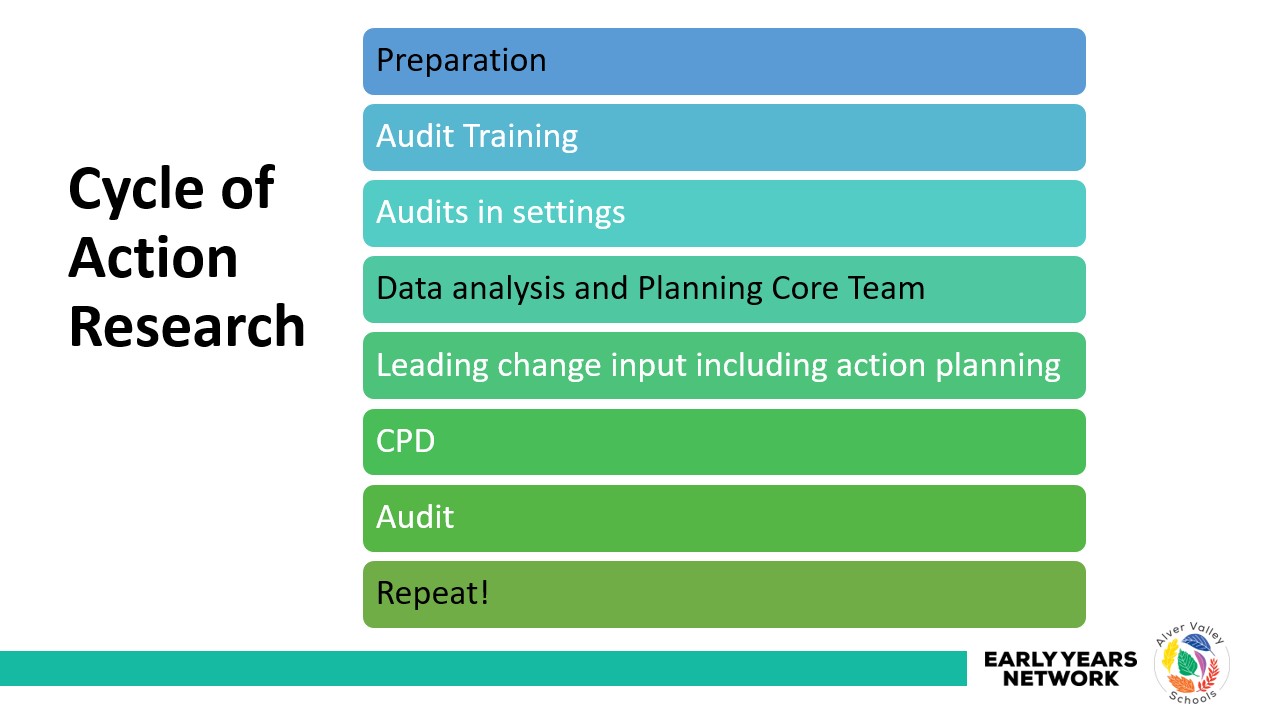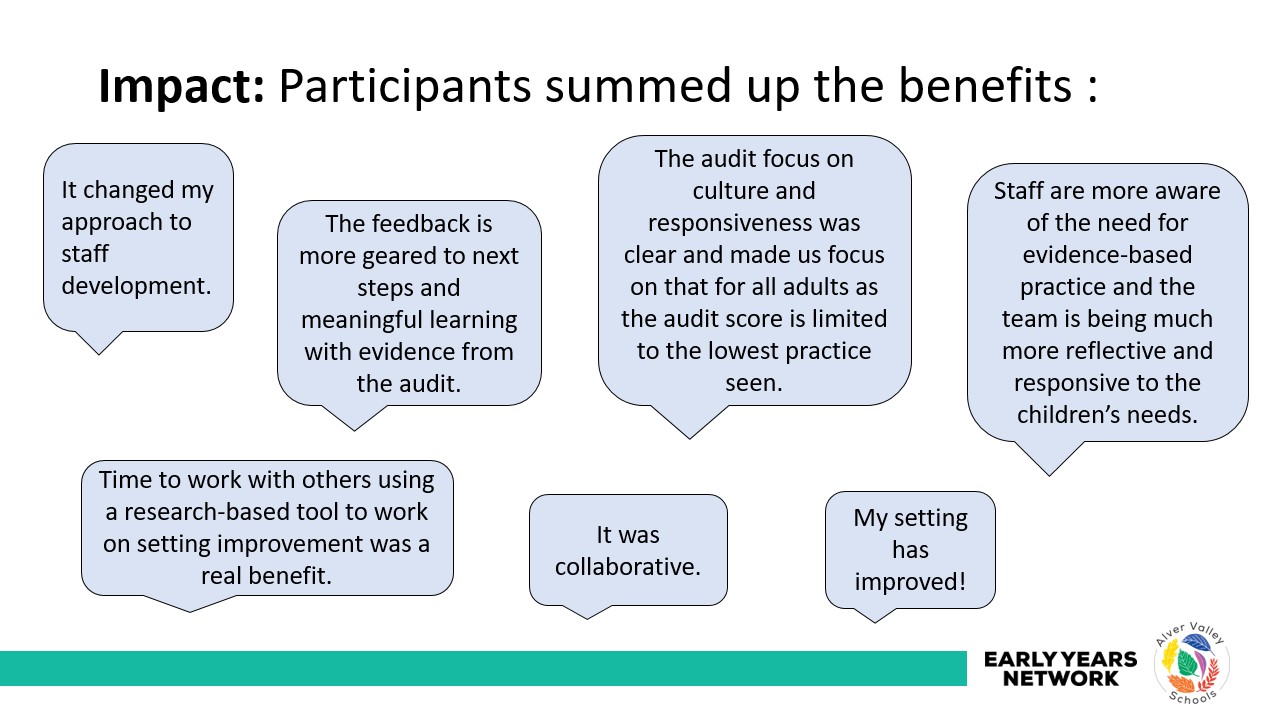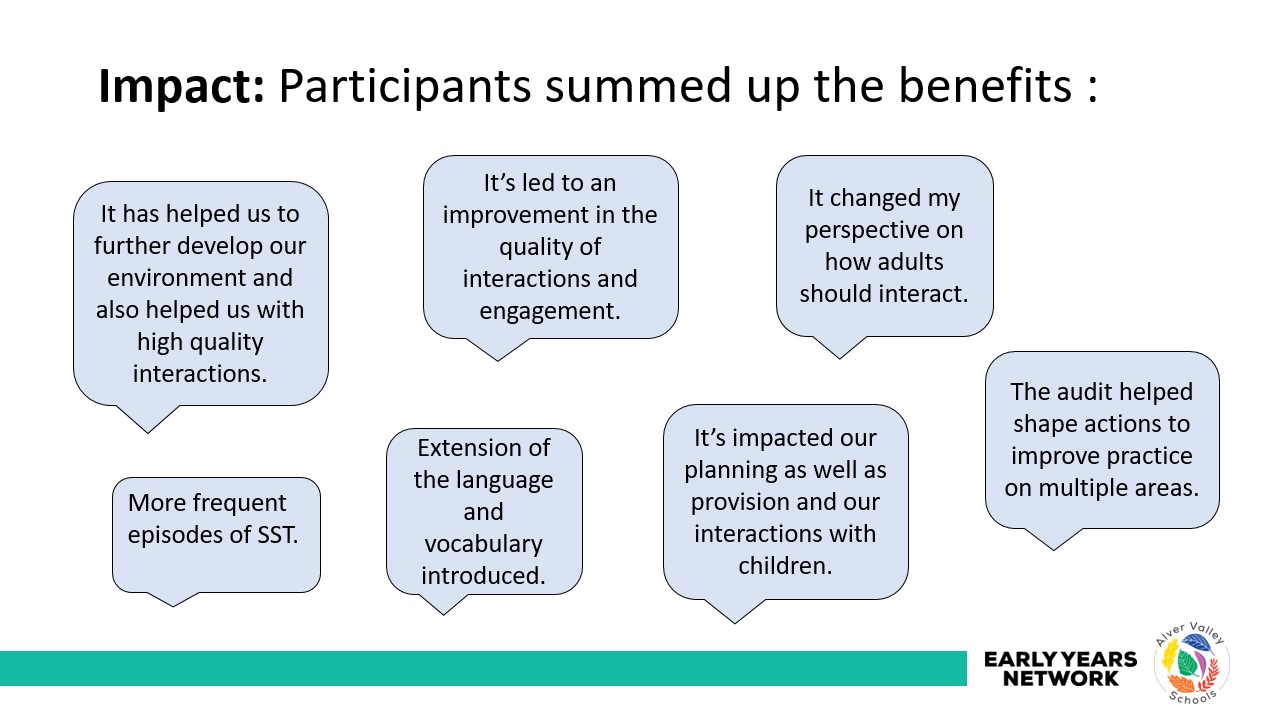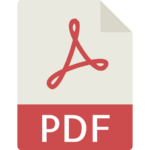
In September 2022 following a successful bid for funds the early years team of Alver Valley Schools embarked on an 18 month project to improve outcomes for children with SEND through improving EY provision with other local providers including schools, nurseries and pre schools. Below is a case study of the project.
Project Title: Alver Valley Schools Early Years Project
The complete project consisted of 2 strands:
- Strand 1: Alver Valley Early Years Network – A forum for Early Years settings in the Gosport and surrounding area
- Strand 2: Action Research Project – Enhancing sustained shared thinking within Early Years settings
This case study will focus on Strand 2 of the project: Enhancing sustained shared thinking within Early Years settings through action research.
You can read more about the Early Years Network on the Network pages here.
Project Summary
The project saw Early Years practitioners from Gosport, Hampshire, engage in collaborative action research that sought to promote young children’s communication and language by enhancing sustained shared thinking within Early Years settings through cycles of action research and implementing the Shared Sustained Thinking and Emotional Wellbeing Tool to inform improvement.
Context
The Alver Valley Schools Early Years Project was aimed at cross sector early years settings in Gosport. The rationale was a response to the need in the locality.
The Alver Valley Early Years Network was first launched in Gosport in March 2022 by Ali Lockwood and the team at Alver Valley Schools in response to consistently high levels of children with a wide range of unidentified and unmet SEND needs entering provisions over a period of many years, resulting in children with SEND and disadvantage struggling to access learning. We found this concern was mirrored by other practitioners in schools, nursery and preschool settings.
Early Years practitioners were keen to work in partnership cross sector to develop our collective practice. Practitioners voiced a perceived lack of support, with themes of developing positive learning behaviours, SEND identification, and developing provision articulated. The aim of the Network was to create a forum for local EY practitioners to work in collaboration cross-phase and sector to develop and share good practice to improve outcomes for children in Gosport.
There was interest within the Network in engaging in research-based improvement in a variety of areas, such as sustained shared thinking, early identification of need and support, and the development of self-regulation. The action research project bid was made in response to this need as an opportunity to develop the ideas further in collaborative action research. The action research project was successfully bid for, and school and preschool settings already engaged in the Early Years Network in Gosport were invited to join.
The aim was that the collaborative action research project would skill practitioners to evaluate and develop their setting’s practice in communication and language with a focus on adult interactions, sustained shared thinking and emotional wellbeing, framed by current research.
Research
Literature points to communication, language, and self-regulation in the Early Years as indicators of future success (Timmons et al., 2016, Robson et al., 2020).
Research and experience informs us of the importance of high-quality Early Years education focused on these prime areas. Development Matters advocates practitioners increase their focus on children who are struggling with their learning to stop gaps in learning from widening, as ‘gaps at the end of the Early Years will, on average, double by the end of primary schooling’ (Development Matters 2021:6).
The contention is that some children that fall into the SEN support bracket in later years have not had the right provision or early intervention to meet their communication, language and PSED learning needs, and by improving pedagogy in this area less children will fall behind and later need SEN support.
‘Communication and language approaches that emphasise the importance of spoken language and verbal interaction for young children’ as an area of good impact (6 months+) low cost with a strong evidence base (EEF EY toolkit).
Highlighted are the benefits of approaches that ‘explicitly support communication through talking, verbal expression, modelling language, and reasoning’ alongside approaches such as reading aloud, discussing books, and explicitly extending children’s spoken vocabulary. Also advocated are approaches aimed at developing thinking and understanding through language, such as SST, a focus of this project.
Shared Sustained Thinking
“An episode in which two or more individuals “work together” in an intellectual way to solve a problem, clarify a concept, evaluate activities, extend a narrative etc. Both parties must contribute to the thinking and it must develop and extend” (Siraj-Blatchford, et al., 2002:9).
The Project Group
The project group consisted of 2 maintained nurseries (one school based), 4 non-maintained preschools/nurseries and 3 Yr R settings. The project saw a move away from schools and other early years providers working apart from each other to working together.
Aims and Skill Development
The aims and skills we wanted to target were identified and the project action plan was written by the project lead Ali Lockwood and shared with the group.
Our aim was that by the end of the action research project:
- Practitioners would be able to understand what Sustained Shared Thinking (SST) is, identify episodes of SST in practice, and know how to best promote episodes of Shared Sustained Thinking in their own context.
- Practitioners would be able to use the Shared Sustained Thinking and Emotional Wellbeing Tool (SSTEW tool) to audit their own setting in terms of what supports or inhibits SST, and identify their own areas for development.
- Practitioners would develop their interactions with children to support communication and language development.
- Practitioners will learn to measure the impact of changes made to support their understanding of how to use an evidence base and action research to improve practice.
- Practitioners would develop their skills in leading implementation within their own settings.
Resources
The project was led by Ali Lockwood, Head of Schools and Early Years Leader of Alver Valley Schools in Gosport, with initial support from a representative from Winchester University and planning support from a Headteacher of a local Nursery. The team met to plan, design and evaluate the action research project, and a wider group of participants met to engage in training and setting level action planning.
After an initial preparation phase of project planning by the core team, the project participants were then trained in the use of the Sustain Shared Thinking and Emotional Well-being Scale audit tool (SSTEW). The core team had advanced training from the makers of the tool in order that they were able to support the group in implementation, and training for all project participants in use of the audit tool was led by SFYC.
The SSTEW scale audit tool was key to the project as it provided an evidence base for settings to use to drive setting improvement and lead change. The SSTEW scale tool was designed to aid practitioners to close the gap between theory and practice supporting practitioners and researchers understanding and identification of high-quality interactions including what supports and the barriers to this.

Phases of Action Research
There were 3 phases to each cycle of action research, and the project implemented 2 full cycles, giving 3 audit data collection points.
Evaluation Phase 1 – Benchmark Established
In December all settings completed their first SSTEW audit and the benchmark data was shared with core team. The data was reviewed by the core team to aid planning for future sessions, to address the common areas of need from the audit. Participants also completed surveys which provided additional insight into their knowledge and understanding in the area.
Implementation Phase 1
In January the core team led training on Leading Change, Reflection and Action Planning. Anonymised cross-sector group benchmark data was discussed with the group along with the common areas for development. Settings were scaffolded to reflect on what their own audit data was telling them and to identify the ‘quick win’ actions and long-term goals to improve practice for their setting. Participants plotted this onto setting level action plans using the given template. Settings also worked together and shared ideas towards improving practice and leading change.
In following sessions, the project group engaged in a range of training sessions led by SFYC that targeted the areas of need identified by the core team based on the audit data to support implementation of change back in settings.
Evaluation Phase 2 – Midpoint Data Established
May 2023 settings completed their 2nd audit and data was again shared with core team to inform planning for the next cycle of action research.
Implementation Phase 2
Action planning and a further round of training was implemented to support practitioners to continue to lead change back in their settings based on the midpoint data. 2 full days training led by James Turnell of Nursery Nook.
Evaluation Phase 3 – Final Project Data Established
February 2024 final audits completed and shared with the core team.
March 2024 Final group session took place to support the evaluation and review of the project and final action planning for settings.
Over the course of the project, in addition to purchasing training, project funds were used to help fund staff cover for the non-maintained settings to take part. Further funds were used to purchase resources such as books, a video library subscription to be used for staff training in settings, and resources that promote sustained shared thinking, such as loose parts.
Problems or Concerns
As this project spanned two academic years, staff changes impacted implementation for one setting. The capacity to address this was built into the project at the planning stage, as multiple practitioners were trained in the use of the tool and the offer to carry out the audit alongside practitioners was an offer that was made to the whole group. A member of the core team was able to support the setting experiencing staff change to complete the audit tool alongside the new practitioners.
A potential barrier to engagement for settings is staff absence, making it difficult to make time to complete the audit. Buffers were built into the project at the planning stage to allow settings time to complete this (2-week window evaluation window).
As with any cross sector or setting project, trust and clear contracting of group culture and how data would be used, including confidentiality, are key to engagement, confidence and therefore project success. This was an important aspect of planning at the preparation phase.


Benefits
The main strengths of the approach taken in the project can be summarised as:
- Use of a clear evidence base and rationale for change at setting and group level provided by the audit tool data.
- Using data from the audit tool, settings were empowered to implement an action plan for change, including quick wins and longer-term objectives.
- The use of cycles of action research was supportive of settings developing change as it meant change was tailored to settings.
- The audit tool was supportive of focusing attention on the most pressing areas for improvement at a setting level. It also enabled the core team to ensure training was targeted rather than generic.
- The audit tool, when utilised effectively, can be supportive of bridging the gap between research or theory and practice, as it describes what good practice looks like in the area being audited.
- The use of the audit tool midpoint to celebrate progress and refocus on sticky areas that required further work enabled settings to reflect on the impact of changes made to date and consider their next steps revisiting the impact supports embedding change.
- The collaborative nature of the project meant settings could also learn from the shared experience of implementing change and use of the audit tool, where common barriers existed to share how they could also be addressed.
Participants summed up the benefits of the project in this way:
- Time to work with others using a research-based tool to work on setting improvement was a real benefit. It changed my perspective on how adults should interact. It changed my approach to staff development. It was collaborative. My setting has improved!
- It has helped us to further develop our environment and also helped us with high quality interactions.
- It’s impacted our planning as well as provision and our interactions with children. It’s led to an improvement in the quality of interactions and engagement.
- More frequent episodes of SST. Extension of the language and vocabulary introduced.
- Staff are more aware of the need for evidence-based practice and the team is being much more reflective and responsive to the children’s needs. The feedback is more geared to next steps and meaningful learning with evidence from the audit.
- The audit helped shape actions to improve practice on multiple areas. The audit focus on culture and responsiveness was clear and made us focus on that for all adults as the audit score is limited to the lowest practice seen.
These responses are also supported by the data. Audit data from the Sustained Shared Thinking and Emotional Well-being Scale audit (SSTEW) Benchmark to Endpoint shows an increase in average scores across all settings and all subscales of the audit.
The most notable increases in the audit subscales were:
- Subscale 2 Social and emotional well-being: Increase of 1.9 points.
- Subscale 4 Supporting learning and critical thinking: Increase of 2 points.
- Subscale 5 Assessing learning and language: Increase of 2 points.
The items within subscales with the largest increase were:
- Item 12 Supporting concept development and higher order thinking: Increase of 2.6.
- Item 2. Encouraging Choices and Independent Play: Increase of 2.1.
- Item 11 Encouraging sustained shared thinking in investigation and exploration: Increase of 2.1.
- Item 7, Staff support children’s language use: Increase of 2.
- Item 9 Supporting curiosity and problem solving: Increase of 1.9.
- Item 4. Supporting Socio Emotional Well-being: Increase of 1.9.
- Item 8 Sensitive Responsiveness increase of 1.8.
- Item 14 Assessing Language Development: Increase of 1.8.
- Item 13 Using Assessment to Support an Extend Learning Critical Thinking: Increase of 1.7.
- Item 10 Encouraging Sustained Shared Thinking through Storytelling, Sharing Books, Singing and Rhymes: Increase of 1.6.
- Item 3 Planning for small group and individual interactions. Adult deployment: Increase of 1.6
Evaluation
The way the SSTEW Scale audit works is that you score to the lowest practice observed, and so this means there is an onus on settings to ensure all practitioners within the setting are implementing consistently strong practice. This puts a requirement for the participants to share CPD within their setting to strengthen practice.
Practitioners identified that episodes of Shared Sustained Thinking in settings have increased following engagement in the project.
Practitioners highlighted that their engagement in the project helped them to reflect on practice to identify true SST. They identified that this has supported the children’s overall engagement and development of higher thinking and problem-solving skills.
They reflected that the project identified a training need in the workforce as not many practitioners were aware of what SST was, and that it also caused them to reflect on the environment and the resources to support sustained shared thinking along with the adult interaction and role.
One practitioner commented that they now look for more opportunities to extend children’s thinking in everyday practice, that they are more conscious of the questions they ask, how they lead the play, or step back from it, and how they encourage children to use an inquiring mind. Highlighting their changed viewpoint that SST is a fundamental skill and an enquiry approach encourages deeper thinking.
Other feedback on the impact of the project includes the following:
I am more mindful of the questions I ask children, the conversations I have around learning in play and what I talk to my colleagues about. I look for opportunities to use SST and want to include more opportunities for fascinations and wondering within the day.
Our increased use of open-ended resources has supported the children’s planning, thinking and negotiation skills.
Our questioning as a whole team has improved and we are modelling more of the language and thinking that we want to hear from the children. We are more aware of the vocabulary we use and as a unit we are encouraging the children to expand their answers, use reasoning in their responses and justify them.
The Future
The audit tool will continued to be used as a self-evaluation tool within our own Nursery and Year R classes to continue to shape improvement.
Implementing an evidenced based approach to improvement with a clear rationale for change is vital and supports buy in from all stakeholders in the change. This will continue to be a key part of implementing change as will establishing clear objectives and review points.
To find out more about the approach in Early Years at Alver Valley Schools check out our curriculum pages or Spotlight Articles Hooks into Books, Hooks into Books: Year R Meet the Gingerbread Man, Hooks Into Books – Room on the Broom, Messy Art Day.
References
- EEF EY Toolkit Available at: https://educationendowmentfoundation.org.uk/education-evidence/early-years-toolkit. Accessed: March 2022
- Department for Education (2021) Development Matters. Available at: https://assets.publishing.service.gov.uk/government/uploads/system/uploads/attachment_data/file/1007446/6.7534_DfE_Development_Matters_Report_and_illustrations_web__2_.pdf
- Robson, D. A., Allen, M. S., & Howard, S. J. (2020). Self-regulation in childhood as a predictor of future outcomes: A meta-analytic review. Psychological Bulletin, 146:4, pp324–354. Available at: DOI:10.1037/bul0000227 (Accessed 21st April 2021).
- Siraj-Blatchford, I., Sylva, K., Muttock, S., Gilden, R. and Bell, D. (2002), Researching Effective Pedagogy in the Early Years (REPEY): DfES Research Report 356. London: DfES, HMSO.
- Timmons, K. Pelletier, J. and Corter, C. (2016). Understanding children’s self-regulation within different classroom contexts, Early Child Development and Care, 186:2 pp249-267. Available at: DOI: 10.1080/03004430.2015.1027699 (Accessed 7th April 2021).


